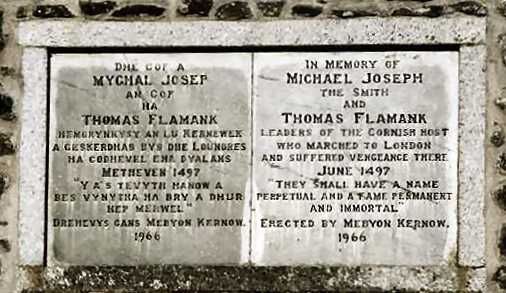The unsung qualify of the 1497 leadership – why we marched for him….
It has been said that the Cornish like arguing a point. Much of their history is known through their exploits in court to prove it! We should not, therefore, be surprised to find a lawyer as one of the leaders of the Cornish Uprising against Henry VII’s tax to fight the Scots in 1497. The late S.T. Bindoff. of Tudor England fame (Penguin, 1950) and my professor at Queen Mary College. London. styled Thomas Flamank of Bodmin “the brain” of the affair: and so he was. Only an appeal to the head would have drawn other than a motley crew, who would have been defeated long before reaching the capital. Our own Tudor historian, par excellence, Dr. Rowse, in his Tudor Cornwall (Cape, 1941), suggested that it was no rabble of the unruly which set off from Bodmin.
Members of the gentry, and burgesses, were there, keeping retainers in check. This is, doubtless, why the Cornish army, said to have been of some 15,000 men, made its way up through the western counties “without any slaughter, violence or spoil of the country”. It, also, explains why gentlemen farmers joined them as they progressed through Devonshire. When they reached Wells, in Somerset, Lord Audley was gained and sympathisers from the cathedral chapter. Bodmin’s Thomas Flamank, however, who appealed to the heads of Cornish society, has been somewhat eclipsed by his partner, Michael Joseph, An Gof (the smith), of St. Keverne on the Lizard.
This is because, in one of the most popular of Tudor literary works, the Mirror for Magistrates, Cornishman Humphrey Cavell sang his praises in a poem. So he should have for, in Bindoff’s style, he was the “brawn” of the affair; yet he, it may be noted, was no peasant but a tradesman. Flamank’s argument – which swayed tradesmen, burgesses, yeoman, gentry, clerics and, eventually a noble, and their entourage – concerned the law. Escuage or shield service, whereby a person of means gave military service for forty days a year, was the lawful way in which Henry VII could raise an army, he maintained. The king had no right to apply to parliament for money; and it had no business imposing a poll tax, payable in May and November of 1497, with an extra subsidy of £120,000. Neither his eloquence for legality, however, nor the fact that it was, at first, directed towards the king’s councillors, Morton and Bray, rather than Henry VII, made Bodmin’s lawyer so appealing.
The truth was that Thomas Flamank sat at a tax-man’s table. He was heir to one of the four commissioners for assessing the king’s subsidy in Cornwall. The son of Richard Flamank of Boscarne and Jane. daughter and sole heir of Thomas Lucombe of Bodmin, he was married to Elizabeth Trelawney of Minwenick; and their daughter, Jane. married Peter Fantleroy. He. also. had two brothers and two sisters: but apart from a close family of good marriages, Thomas Flamank had more to lose by taking a stand against what he saw as injustice. There was the reputation of his surname. Spelled variously – Flandrensis, Flemyng. Flamock – it denoted a Flemish provenance; and forebears had served kings, including and since the Conqueror. Among the knights was a Sheriff of Cornwall, in 1201. Both of his grandfathers had sat in parliament for Bodmin; they, and also his father, had held office as mayor.
There were, too, the lands he was set to inherit. These stretched, west and north of Bodmin, to Padstow and Camelford; and to the south. In his own right, he would have sat at Boscarne, Lord of the Manor of Nanstallon: a Flamank title for the past two centuries, which would continue for another four. Instead prayers were probably offered for the son and heir -taken in the field on Saturday, June 17th and executed at Tyburn on Tuesday, June 27th, 1497 – in the chapel attached to Boscarne House. It had been licensed in 1379 and dedicated to Mary. Official genealogies affirm the pedigree of Thomas Flamank; but humbler, primary sources, regarding later generations, confirm his family trait – a willingness to stand for right, at a cost of living, liberty and, in his case, even life. When the Act of Uniformity, in 1662, obliged clergy to use a prayer book unacceptable to puritans, Thomas’ great, great, great nephew refused on principle. Ejected from his Lanivet living, he set up a meeting house at Gonronson in St. Enodor. A first cousin of this Flamank was “the Quaker Saint of Cornwall”, Loveday Hambly, who suffered imprisonment four years before, as a conscientious objector to church dues. Boscarne House was licensed as a public meeting place for dissenters, its chapel having been re-built in 1690. Within a century, a Flamank was numbered amongst John Wesley’s Cornish friends and built a chapel on the site of St. Austell’s later Baptist schoolroom. Whether the Flamank nonconformity sprang from the events of 1497 is open to conjecture. What is not that Thomas Flamank stood up for what he believed was right – and died for it. That is why we marched for him this year.
